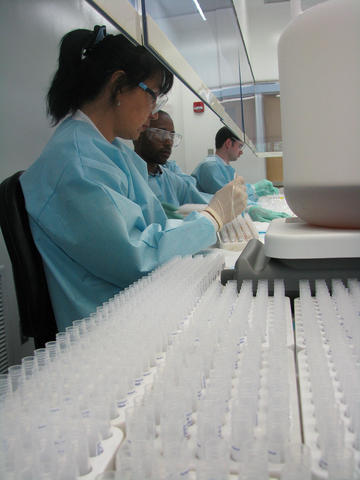
(L to R) Gulchekhra Shakirova of the CDC and NIST’s Savelas Rabb and John Molloy package SRMs 2668 and 3668 at the CDC.
NIST scientists have thoroughly measured and characterized more than 1,300 physical products, NIST Standard Reference Materials®, to help people in industry, academia, and government agencies calibrate instruments, verify their test methods, and develop new measurement methods. NIST reference materials, for example, help manufacturers make interoperable parts in far-flung facilities, medical labs check the accuracy of cholesterol and other clinical tests, and scientists monitor environmental threats.
We feature a different NIST reference material in each issue of Material Matters, the quarterly magazine of the Material Measurement Lab. (Click to subscribe.) This story appears in the Winter 2017 issue.
What
Standard Reference Material® 2668 Toxic Elements in Frozen Urine, and 3668 Mercury, Perchlorate, and Iodide in Frozen Human Urine
Together, these two SRMs provide values for more than one dozen environmental contaminants that are harmful to human health, plus a few nutritional elements that public health authorities monitor.
Each SRM contains 10 vials, each with 1.5 milliliters of frozen human urine. Five vials in each SRM contain concentrations of the elements of interest that represent the 50th percentile of the U.S. population (that is, 50% of us have concentrations of, say, mercury in our urine below the levels in the SRM.) Five vials contain concentrations of the elements of interest that represent the 95th percentile. Most test labs will see samples that fall within this range, since it covers so much of the population.
Why
SRMs 2668 and 3668 help the Centers for Disease Control and Prevention (CDC; which collaborated on their development) and other labs monitor people’s exposure to toxins in the environment.
Each SRM provides multiple vials so that customers can run multiple quality control checks, comparing their results to NIST’s. If the test labs results aren’t with the range specified by NIST, customers know to look for problems with their test processes or equipment.
NIST has supported the nation’s public health system with reference materials for toxins in urine since the early 1980s, but those were freeze-dried samples that had to be reconstituted with water, introducing the possibility of errors. In clinical chemistry, a best practice is to match your reference material’s characteristics to the properties of the kind of samples you usually see in your lab. Since urine tests in clinical labs are conducted on liquid samples, NIST developed liquid SRMs to more closely imitate real-world conditions.
Who
Since the early 1960s, the CDC has conducted surveys on the health of the population. A new survey—questionnaires and medical and dental exams of 5,000 people in 15 counties—begins every other year. The CDC’s findings help to shape public policy and new health programs and services. For example, information from the health survey about the nutritional status of Americans informed a program to fortify bread, flour, cereal and other grain products with folate, critical to the correct formation of the spine in developing embryos. After folate was introduced into products, The CDC’s health survey saw a 33% reduction in the number of women of childbearing age with low levels of the nutrient. The survey’s findings on the population’s levels of lead prompted the removal of lead from gasoline and helps the CDC pinpoint areas where lead contamination (such as from old paint) is still an issue.
The survey continues to monitor the population for lead and other environmental contaminants, and is now monitoring for some emerging contaminants like perchlorate, a component of rocket fuel and some fertilizers. Perchlorate in the environment concerns public health experts because it can interfere with the thyroid gland’s absorption of iodine, essential for production of thyroid hormone. The Environmental Protection Agency is considering regulating perchlorate in drinking water. Recognizing the increasing interest in perchlorate, the NIST team developed SRM 3668, the world’s first reference material for the substance.
How
No humans were harmed in the making of this product: The CDC, with permission from a board that examines the ethics and safety of studies involving people, collected some 34 liters of urine from, no doubt, a lot of volunteers. For each SRM, the urine was homogenized, divided into two portions, and spiked to represent the concentrations of the elements of interest in the 50th and 95th percentiles of the U.S. population. The SRMs are stored and shipped frozen and thawed at room temperature before use.

